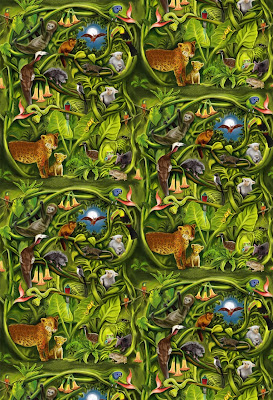 |
| My illustration as a repeating pattern |
This week's topic for Illustration Friday's challenge is "Jungle." Once again, I have submitted an older piece that I recently reworked into a repeating pattern.
This illustration started out as a portfolio piece depicting various animals of northern South America's rain forests. From the start I challenged myself to show as many animals as possible (including a few birds and butterflies). After consulting a number of photographic reference books, I came up with a sketch that wove the animals together into a leafy background, joined together and encircled by vines. If you scroll down, you can see images showing the progression of the piece.
Some of the animals included in my design are: Brown Capuchin monkey, Two-toed Sloth, Silvery Marmoset, Brazillian Porcupine, Greater Bulldog Bat, Murine Mouse Opossum, a Jaguar and her cub and a Quetzal. I was going for a sort of vintage children's book feel so I took a little liberty with how some of the animals look. In other words, I tried to make their faces a little cuter.
After completing the rough sketch, I began to block in some color. I painted the image in Painter 11 and in order to be able to easily make changes in positioning and color, I used lots of separate layers. I continued to add layers and to block in colors and refine shapes, adding darks and lights as I went. I worked on this illustration on and off for several weeks during 2009 and 2010.
 |
| My original pencil sketch |
In June of this year (2013) I resurrected the image and turned it into a repeating pattern for printing on fabric that I sell through my
Spoonflower shop. Creating a repeating pattern out of a finished illustration was a bit of a challenge and I went through a lot of trial and error. To do this, I opened the image in Painter 12 and captured the original image as a pattern. When Painter asked me to name the pattern I was also able to select an offset. Since I didn't want a straight across grid-looking pattern, I chose a 50% vertical offset which would stagger the image when it repeats. Once I had the pattern saved to the pattern library I went to the pattern menu and selected 'Check out pattern." This brought the pattern up as a native Painter rif file that had edges which would automatically tile. In other words, when I painted off of the right edge, the same line would continue to paint in the correct location over on to the left edge. The same thing would happen for the top and bottom edges. Working in this mode is very memory intensive and it helps if you have a lot of RAM installed. I have quite a bit, but I still saw my brushes slow down when they approached one of the edges.
Every once in a while I would stop and save the image in two formats - as a native rif file so that the tiling would continue to be active when I reopened it in Painter, and as a photoshop file so that I could open it in Photoshop and quickly create a sheet where I duplicated the image several times to see how various elements along the edges were lining up. When I was happy with how everything was lining up, I again saved the final version in Painter as a photoshop file. After opening it in Photoshop and making last minute adjustments on brightness and saturation levels, I saved the image as a jpeg for uploading to Spoonflower.
 |
| Initial color blocking with the sketch visible on another layer |
 |
| Starting to add darks, more defined edges and smaller details |
 |
| The finished illustration |










